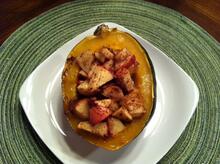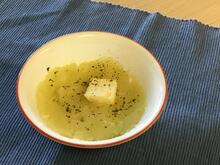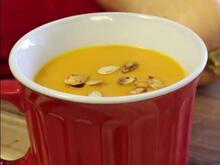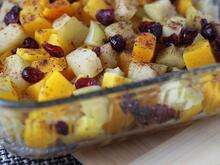
After a multiday team meeting, our group went out to dinner. A special at a local restaurant was a whole pumpkin, scooped out and filled with mashed pumpkin, seafood, veggies, and sauce. It was a hit!
While they're tasty and make for festive decorating, I find winter squash intimidating to cut up since many varieties of winter squash don't have flat surfaces to place securely on a cutting board. Haven't cut myself yet, thankfully.
Nutritionally, one cup of cubed butternut squash contains around 82 calories, 22g carbohydrates, and 7g fiber, and contains vitamins and minerals, including vitamins A and K, multiple B vitamins, and magnesium. Butternut squash is not a significant source of fat, protein, or sodium. (This nutrient profile is similar in most winter squash.)
- Types: Common winter squash in stores are butternut, acorn, and spaghetti. Local farms might sell other varieties, such as delicata, buttercup, and kabocha squash. And, of course, classic orange pumpkins.
- Buy: Look for winter squash that are firm and heavy with a deep-colored skin. The exterior should be hard, without soft spots, mold, or broken areas. (Be aware that not all winter squash are tasty once cooked. Check with your local Extension office or an area pumpkin farmer to learn about edible varieties.)
- Price: Winter squash averages $1.20 per pound, according to USDA Fruit and Vegetable Prices.
- Store: Whole winter squash store for a long time - from weeks to months - in a cool, dry location.
- Prepare: Wash under cool water and prepare per recipe. This might be cooked whole or cut into pieces. If cut, remove rind with a knife or vegetable peeler, scoop out seeds with a spoon, and cut into the size pieces called for in the recipe. Watch our video - Cooking with Winter Squash - for more instructions.
- Preserve: While there are no USDA or Extension tested recipes for canning pureed winter squash, National Center for Home Food Preservation shares instructions for canning cubed squash, freezing winter squash, drying pumpkin seeds and drying the flesh.
- Eat: Use winter squash in sweet and savory recipes. Popular recipes include mashed, roasted, and in soups. Or keep the skin intact for stuffing with squash and other ingredients.
Roasted Delicata Squash | Print recipe | Watch video
Serves 2
Apple-Stuffed Acorn Squash | Print Recipe
Serves 4
Roasted Butternut Squash with Cherries | Print recipe
Serves 4
Mashed “Potato” Squash | Print recipe | Watch video
Serves 2
Spaghetti Squash with Meatballs | Print Recipe
Serves 6
Butternut Squash-Carrot Soup | Print Recipe | Watch Video
Serves 4
Squash, Apple, and Cranberry Casserole | Print Recipe | Watch Video
Serves 6
Spaghetti Squash Alfredo | Print Recipe
Serves 4
Related Blog Posts:
Resources:
-
Iowa State University Extension, Preserve Pumpkin and Squash Safely, 2021
-
North Carolina Cooperative Extension, Savory Winter Squash Recipe, 2020
-
North Dakota State University Extension, Field to Fork, Winter Squash!, 2020
-
PennState Extension, Let's Preserve: Squash and Pumpkins, 2021
-
PennState Extension, Winter Squash Enhances Fall Meals, 2016
-
University of Illinois Extension, Eat.Move.Save., Winter Squash
-
University of Illinois Extension, Winter Squash - Watch Your Garden Grow
-
University of Maine Extension, Bulletin #4176, Vegetables and Fruits for Health: Winter Squash and Pumpkins, 2008
-
University of Massachusetts Extension, Winter Squash, N/D
- University of Nebraska-Lincoln, Winter Squash, N/D
-
United States Department of Agriculture, FoodData Central
Post originally published in 2014; content updated in 2022.
Healthy Eats and Repeat
How much difference is there between canned and frozen foods? How should you cook venison? When is the best time to buy avocados? Get answers to these questions as well as other tips, tutorials and recipes for common kitchen foods and items with University of Illinois Extension Nutrition & Wellness Educator Caitlin Mellendorf. Build your best life. Trust Extension to help.
Caitlin Mellendorf is an Illinois Extension Nutrition and Wellness Educator serving DeWitt, Macon and Piatt Counties in Central Illinois. She is a Registered Dietitian and her work focuses on helping community members gain the knowledge, skills and tools to live healthier, more nutritious lifestyles. This includes providing programs and answering questions about heart health, diabetes, food safety, food preservation, grocery shopping and cooking. You can reach Caitlin by email at chuth2@illinois.edu or call 217.877.6042.







